You don’t need to be Bible scholar or seminary graduate to read and study the Bible. What you do need to do is pay attention to what the Bible says and doesn’t say. When I was a very new Christian in 1973, I attended a Tuesday night get together called The Green House in Fort Lauderdale, Florida. It was a complimentary ministry of Coral Ridge Presbyterian Church. It was a place where other young people could attend a place that was more relaxed and less threatening than Coral Ridge. The teaching at the Green House was as solid as you would get at Coral Ridge.
First time visitors, no matter who they were or their background, heard the gospel in a separate class. There was great fellowship and Bible study and even a free meal. It was held in the home of Rennie and Virginia Schmidt. It was Virginia who encouraged me to go to seminary.
One young man impressed me with his knowledge of the Bible. His name is Neal Ganzel. At that time, I didn’t know much about the Bible, but I wanted to learn. So, I asked Neal how he was so knowledgeable. He said, “I use a concordance.” There was no internet. If you wanted to cross reference passages, you used either Strong’s or Young’s Analytical Concordance. Young’s has been revised and updated over the years. They are big fat books, but they were necessary if you wanted to study the Bible unencumbered by interpretive systems. If you wanted to know how many times and where a word is found in the KJV, all you needed to do was check out the concordance. Strong’s included a Hebrew and Greek dictionary linked to its own numbering system. For example, the word “world.” In the example below, in Matthew 24, three Greek words are translated as “world.” You know this because of the three different dictionary numbers: 165 (aion/age), 3625 (oikoumenē/inhabited earth or known world), and 2889 (kosmos/world). But even kosmsos does not always mean planet earth or the whole wide world (e.g., Rom. 1:8). Context matters. It’s not much different in the way we use the word “world” in everyday speech.
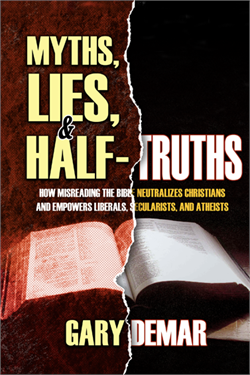
Myths, Lies, and Half-Truths
Myths, Lies, and Half-Truths takes a closer look at God's Word and applies it to erroneous misinterpretations of the Bible that have resulted in a virtual shut-down of the church's full-orbed mission in the world (Acts 20:27). Due to these mistaken interpretations and applications of popular Bible texts to contemporary issues, the Christian faith is being thrown out and trampled under foot by men (Matt. 5:13).
Buy NowAlthough these different words are translated as “world” in the KJV and some other translations, each Greek word has a distinct meaning. Notice that in Matthew 24:14 and Luke 2:1, the same Greek word is used, number 3625, oikoumenē. Knowing this might offer some help as to why Jesus used the same word in Matthew 24:14, the only time in Matthew’s Gospel that oikoumenē is used.
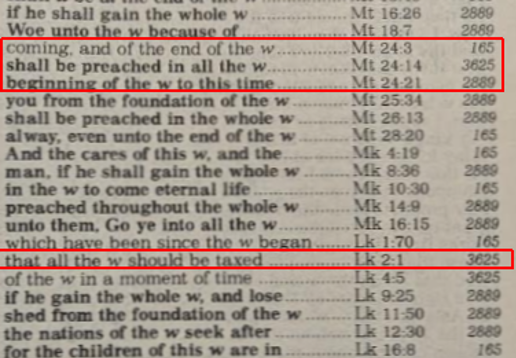
Young’s Analytical Concordance takes a different approach. It took Robert Young around 40 years to complete his work that included three years of typesetting. Under the word “World,” as translated in the KJV, each specific Greek word has its own category listed. In this case, the word oikoumenē.
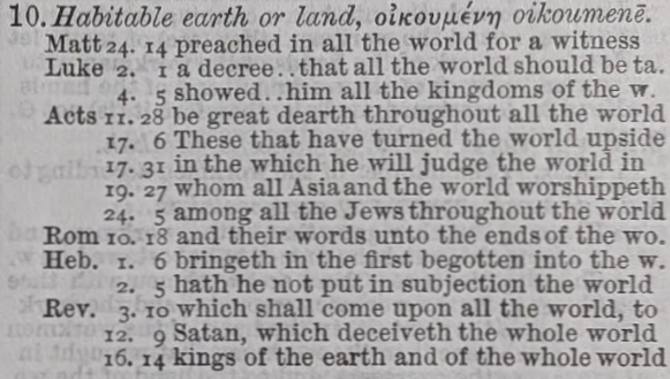
Anyone studying eschatology who does not deal with how the NT uses specific words related to the topic is being dishonest and is letting a predetermined system interpret Scripture. The average Christian does not know anything about these word differences.
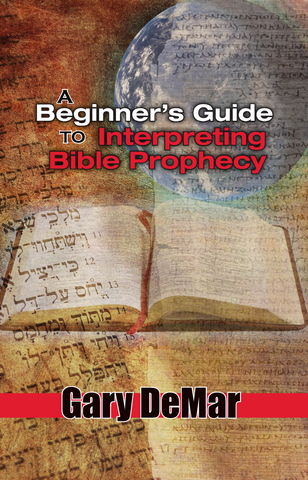
A Beginner's Guide to Interpreting Bible Prophecy
With so much prophetic material in the Bible — somewhere around 25% of the total makeup of Scripture — it seems difficult to argue that an expert is needed to understand such a large portion of God’s Word and so many “experts” could be wrong generation after generation. If God’s Word is a lamp to our feet and a light to our path” (Psalm 119:105), how do we explain that not a lot of light has been shed on God’s prophetic Word and with so little accuracy? A Beginner’s Guide to Interpreting Bible Prophecy has been designed to help Christians of all ages and levels of experience to study Bible prophecy with confidence.
Buy NowThe same is true for the Greek word “antichrist.” If some prophecy “experts” are to be believed, THE antichrist is all over the Bible. In reality, the word “antichrist” only appears in four verses and is specific in its definition, number, and time of appearance:

When people on Facebook write about the supposed coming end-time antichrist, I ask these questions:
Could you (1) reference the verses where the word “antichrist” is found, (2) define antichrist by using the Bible’s definition, (3) identify the number of antichrists, the time of their appearing, and (4) explain how these describe a yet future prophetic figure? Here’s what the Bible says and doesn’t say about antichrists:
- “Antichrist is primarily a Christian term based on interpretation of passages in the New Testament, in which the term ‘antichrist’ occurs five times in 1 John and 2 John (Greek: ἀντίχριστος, antichristos), once in plural form and four times in the singular.”
- An antichrist is a “liar . . . who denies that Jesus is the Christ” and “denies the Father and the Son” (1 John 2:22; cf. 2 John 7). It’s most likely that the antichrists were first century Jews who did not believe that Jesus was God in human flesh (cf. Rev. 2:9; 3:9). They were not political leaders and did not possess preternatural powers.
- There were many antichrists (1 John 2:18).
- Antichrists had already “gone out into the world” when John wrote his second epistle (2 John 7).
- Earlier John had written that “even now many antichrists have appeared; from this we know that it is the last hour” (1 John 2:18). The “last hour” is most likely a reference to the events surrounding the destruction of Jerusalem that took place in AD 70.
- The book of Revelation does not use the word antichrist which seems odd since it’s during this future time that we’re told THE antichrist will oversee the rebuilding of another temple, make a covenant with the Jews, and break that covenant, events the last book of the Bible do not mention.
Antichrist theorists will argue the Bible describes a “composite” antichrist: “the son of destruction” and “the man of lawlessness” (2 Thess. 2:3), “the prince who is to come” (Dan. 9:26), “the little horn” (Dan. 7:8; 8:9), “the beast”—there are two of them—(Rev. 13:1, 11), and several other biblical characters all rolled into one. But based on the Bible’s own definition, number, and timing of the antichrists in John’s day, the composite antichrist argument does not work. The exception may be with the man of lawlessness in 2 Thessalonians 2. (See my book Last Days Madness for a two-chapter study of 2 Thessalonians 2)
Below is a response I made to a comment made on a Facebook post about Matthew 24. Audience relevance is important. Who are the “you” throughout the chapter? There was an audience who heard what Jesus said. For example, when Jesus said, “you will be hearing of wars and rumors of wars,” who were the “you”? When Jesus said, “they will deliver you up to tribulation, and will kill you,” who were the “you”? They were the same “you” mentioned in Matthew 10:17 (see Acts 5:40; 22:19; 26:11; 2 Cor. 11:24-26). Jesus was not referring to a distant future audience. Put yourself in the place of those who heard Jesus. Would you have thought that the use of “you” meant someone else? The capstone is what Jesus said in Matthew 24:33: “so, you too, when you see all these things, recognize that He [or it] is near, at the door.” Is the second “you” different from the first “you”?
For a detailed study of parts of Matthew 23 and 24, see my book Wars and Rumors of Wars.
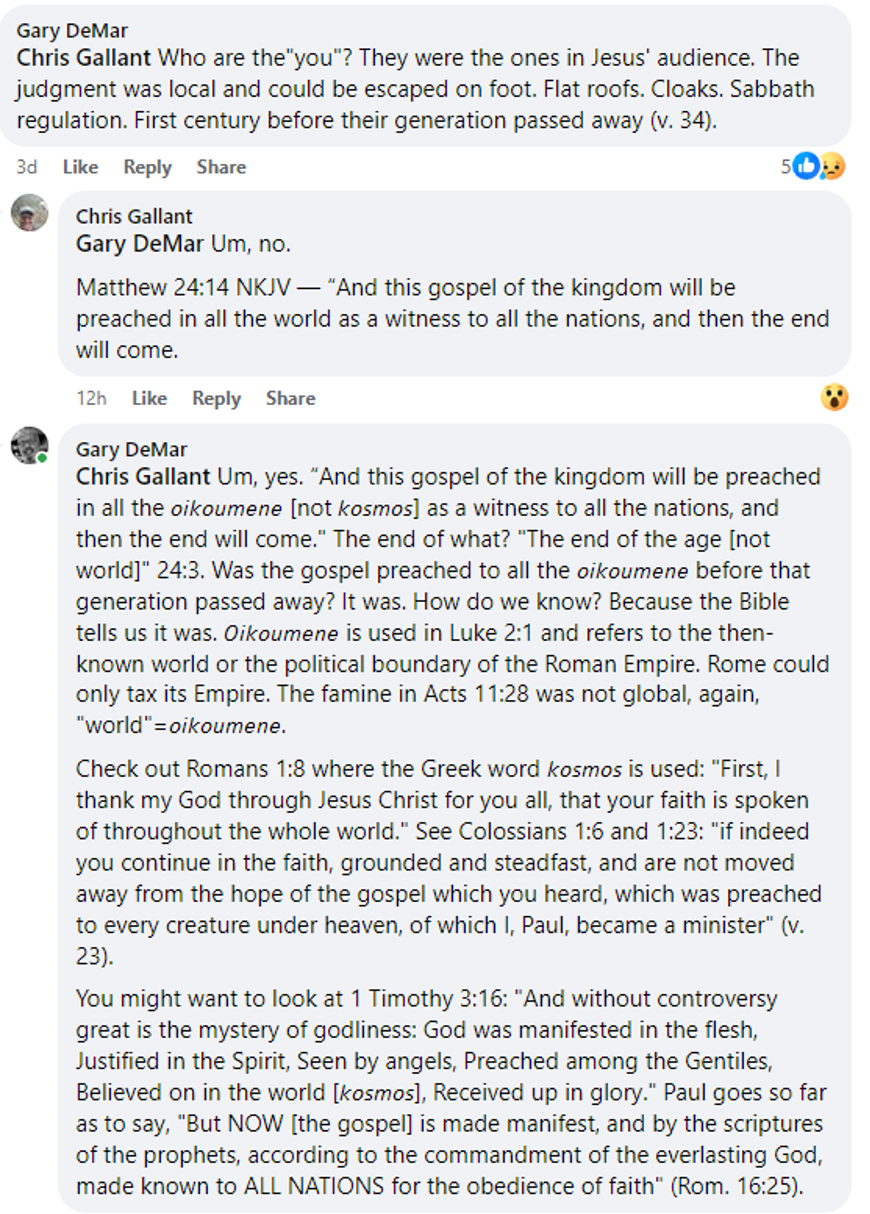
For additional prophetic study, see the following:
Matthew 24 Fulfilled by John Bray
Matthew 23-25 by James Jordan
The Rapture and the Fig Tree Generation by Gary DeMar and Francis Gumerlock
Is Jesus Coming Soon? by Gary DeMar

